Here we are. Oscar season. Instead of adding to the discussion about this year’s nominees and snubs, I instead wanted to look at the best picture winner from 1952: “The Greatest Show on Earth“. Now even though it took home the Academy Award for best picture, it’s often regarded as one of the worst winners ever. Not only for the film’s own quality (44% on Rotten Tomatoes from critics and a 56% from the audience), but the fact that it pulled the upset over “High Noon“, a film regarded as one of the greatest westerns and often finds itself on a number of lists from the American Film Institute.
The thing is, the Oscars are full of politics, outside influence, and can play to the moment just as much as the past or the future. Citizen Kane failed to win best picture, yet nobody remembers the film that defeated it. Cher beat out Glenn Close and Meryl Streep for a win. Due to all the insanity in recent years, people are sometimes surprised (or in denial) that Nicholas Cage has an Oscar to his name. That’s not to discredit any of the winners or elevate the losers, just saying it’s not as cut and dry as picking the best performances or works.
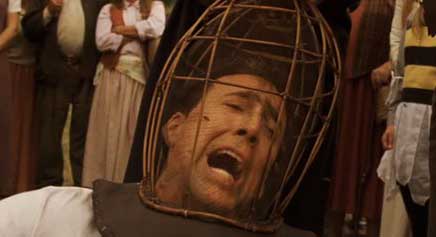
Then again, this guy won an Oscar
For those that are unfamiliar, “The Greatest Show on Earth” was a star-studded effort headlined by a legendary director that was supposed to be the spectacle of its day. With assistance from the Ringling Bros. and Barnum & Bailey’s Circus, the film showed us circus life both within the glory of the big top and the sweat that went into bringing such wonders into each and every town. Part documentary, part drama, part romance, part death defying stunts, there truly was something for everyone.
The issue is, the film is almost too amibitious and too big. There are plot lines involving the business end of the circus, the rivalries formed by competing acts, a love…pentagon(?), and a clown with a mysterious past (with an underappreciated performance by Jimmy Stewart). In addition to bringing up and resolving all these plots, the behind the scenes look of the logistical end of a live circus (which itself makes a compelling documentary) pushes the run time to 2 and a half hours and the viewer begins to feel it. Especially when a good 15-20 minutes of that is just pure circus acts that do nothing to further the plot and another 10-15 minutes just shows the performers on their downtime.
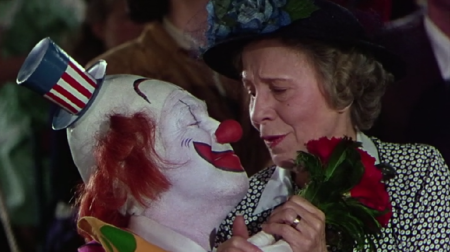
Seriously, I would probably watch a movie just about Buttons’ life.
The film also doesn’t polish that well. The dubbing on some of the musical numbers is obvious and any close up where stunt doubles aren’t possible can be seen through quite easily. I don’t expect actors to magically be capable of performing skills that require years to master, but the illusion becomes less real. For the time it may have been more impressive and it just didn’t age well.
That’s not to say the film is without some positives. Watching the rivalries unfold is entertaining, some pieces of the love pentagon show the difficulties of choosing love vs career, and we get some great acting performances by Stewart, Heston, Cornel Wilde, and Betty Hutton.
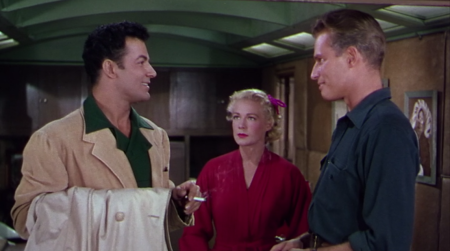
It’s almost weird to see Heston not holding a gun, fighting apes, or wearing clothing from Roman times.
Now let’s look at “High Noon”. A black and white western starring Gary Cooper as former-ish Marshal Will Kane. I say former-ish because at the start of the film, Kane has married and is looking forward to stepping down from his post and plans to start a new life in another town. With his replacement having yet to arrive, Kane receives word that an ex-con holding a grudge is due to arrive in town at noon and he’s bringing a few friends.
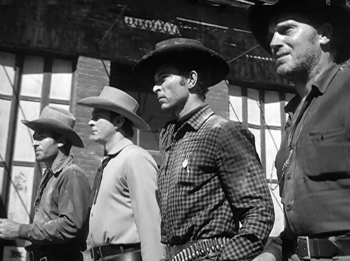
And not the kind that dance to catchy theme songs.
Kane is stuck with a difficult decision: does he stay and fight against his wife’s wishes? Should he run and leave the town unprotected? The majority of the film follows Kane as he contemplates his options with the clock ticking and the train fast approaching. The town closes their doors, shut their windows, and leaves Kane with only his own revolvers to count on. The film runs for 85 minutes, about 56% of “The Greatest Show on Earth”; yet, every minute has an impact as Kane is forced to decide what kind of man he will be in more ways than one.
In a complete contrast to the Oscar winner, “High Noon” is low on both visual appeal (the director insisted on shooting in black and white), and extravagance; but, Gary Cooper carries the film so well and he was cast perfectly as a man almost tired and broken after years of dedication. He was 51 at this point and the studio didn’t really try to hide it. His age works in his advantage to give us an idea of how Kane’s burden and role has affected him. The suspense is built perfectly as Kane journeys through the town he has worked tirelessly to keep safe, only to find that in his hour of need he is left alone.
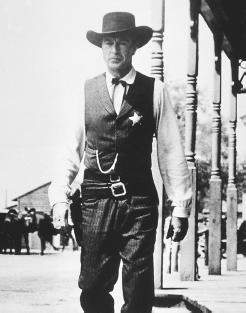
Gary Cooper only needed black and white to look tough, he didn’t need fancy technicolor.
The things is, even after over half a century of aging, it’s obvious that “High Noon” was the superior film. “The Greatest Show on Earth” isn’t a bad film, but it doesn’t meet the bar one would expect of a best picture winner and pales in comparison to the competition. So how did the lesser film win? The main theory that floats around is that the academy voting was a result of blacklisting and the Red Scare. “High Noon” was written by Carl Foreman, who would later leave the U.S. for England as a result of having been blacklisted and some see this work as an allegory for McCarthyism and blacklisting.
The other theory is that voters weren’t so much choosing to honor the best film, but rather the film’s director Cecil B. DeMille. A motion picture pioneer, DeMille had received an honorary Oscar for his life’s work in 1950, but this was the first (and some feared last) time that DeMille would be nominated for best picture. As a result, it is believed that voters gave DeMille an Oscar while they still had a chance.
It honestly reminds me of 2009 when the best picture had pretty much boiled down to “The Hurt Locker” and “Avatar”. This is getting pretty lengthy so to sum it up: “The Hurt Locker” was “High Noon”, a film focused on telling a good story with some action thrown in. “Avatar” is “The Greatest Show on Earth” a visual spectacle with a famous director that suffered from a weaker story (in this case, due to a story many felt was a re-telling of older films in a different setting). In this case, story beat style. But which should we actually reward? There’s really no clear cut answer because style can influence story and vice versa. “Braveheart” and “Titanic” employed epic styles and larger than life feels to enhance their stories, whereas “Rocky” and “The King’s Speech” focused on telling the story of a single man without eye popping visuals or special effects. It just happens to be all very subjective as to what makes a good film. Personally…
Final Verdict: “High Noon” is the superior film, but if you get a chance (and have the time) “The Greatest Show on Earth” is a nice flick to visit.
Final Score: “The Greatest Show on Earth”: 6/10
“High Noon”: 9/10
I’m done here. My brain hurts.
